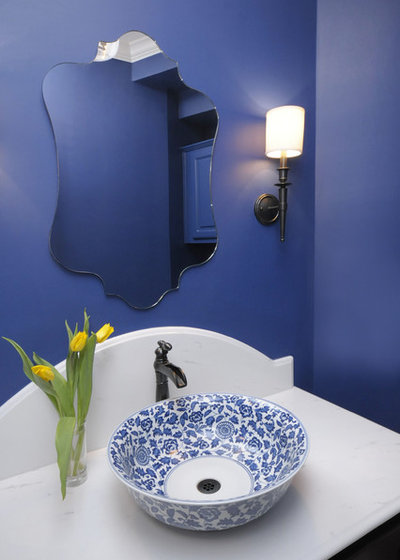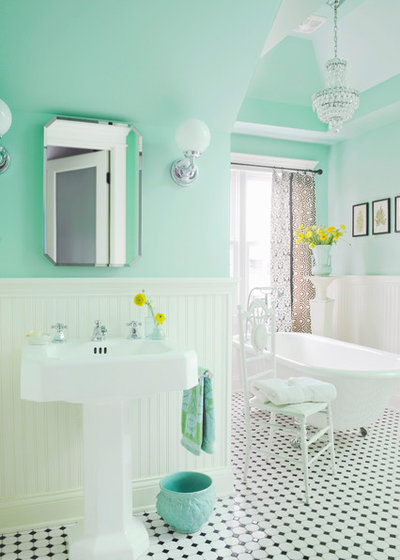While this is not specifically about counter tops, it is relevant to the overall look of your kitchen, bath, bar or office. Finding inspiration is the best way to begin!
Check out this article from Houzz…..
Dressing your home in colors that embody your personality calls for reflection, inspiration and a readiness for risks
There are plenty of places to look if you’re interested in finding out which color choices might mean that you’re creative or quiet or calm. Online quizzes, books and color psychology forums crank out potential explanations for the colors you’re drawn to, but when it comes to decorating your home, the shades you use should really be felt, not analyzed. “Above all, color is a reflection of personality and provides the means to express our emotions,” says Leatrice Eiseman, executive director of the Pantone Color Institute, where experts annually determine a color of the year.
Here are a few hints for homing in on a combination of colors that really says you.
Make Mood Your Starting Point
Colors mean different things to different people. Blue, as seen in this room’s accents, for instance, can come across as breezy and calming to some, cold to others. Eiseman suggests that homeowners design a space around the mood they want that space to convey to them.
In this bedroom, the eggplant wall color continues onto the ceiling — a choice that might feel claustrophobic or cozy, depending on the person in the space.
Keep an Eye Out for Inspiration
If you’re not ready to face a daunting wall of paint chips at the hardware store just yet, start narrowing down the colors you connect with by scrolling through images on Houzzor in the pages of a design magazine and noting which ones spark an emotional response.
Look to nature, which is bursting with colors you can build off of at home. The rich greens and natural woods in this living room, for instance, are all the more soothing complemented by the live plants throughout the space.
Think about which colors your favorite things have in common. “If [the colors] ‘speak to you’ and you are drawn to them, then those colors and combinations will have even more meaning when you paint those same colors on your walls and in your other furnishings,” Eiseman says.
Nature’s Color Wisdom: Lessons on Color From the Great Outdoors
Study the Space
Even if you love a color or a combination of colors, some hues work better in some spaces than others. Nashville, Tennessee-based interior designer Anna Forkum opted for a rich aqua (Benjamin Moore’s Spirit in the Sky) in this vintage-inspired guest bathroom both for its retro vibe and for how it complemented the room’s existing details.
“Having the white wainscot halfway up and then all the angles, it seemed like it could handle a strong color in a small space,” Forkum says.
The structure of a room can affect how a color will appear, so if you’re painting or using color — such as the yellow tiles shown here — for an entire wall or more, test an area first.
A bright floor might make the paint show up a little warmer than the color you love. High ceilings can make a color feel more potent. Painting multiple walls can also create a shift in tone.
“Go a shade lighter on the color wheel, always, than the one that your eye is attracted to, because once you paint four walls that color, the colors just intensify because it’s bouncing off all the walls,” Forkum says. “Try to stay with a dustier version of what you love.”
Once a feeling has been established for the space, translating that into a color often depends on gut instinct.
If there’s one color in particular that feels right, like the warm brown of this Dallas powder room, breaking it up with different textures and forms —penny tile walls and a custom marble surround in this case —can make a statement without going overboard.
Ease Into It
Color can be intimidating. Forkum says many of her clients will start with a more neutral palette and add in more vibrant color over time.
“A lot of times people would rather add the color in a different way, whether it’s furniture or pillows or art,” she says.
In the kitchen shown here, the unexpected orange oven and the playful patterned floor are balanced by the otherwise low-key white walls and cabinets.
Another approach is to paint just one hallway or wall, as in this bold Atlanta living room. If you opt for a lighter paint shade, Forkum says, you can always go darker later.
Forkum says her job as a designer often involves simply validating for clients that the colors that speak to them are the right fit for their homes. “A lot of it is just the fear, whether it’s being told by a peer that perhaps that’s not a good color or an ugly color,” she says. “For me, it’s really just the client trying to figure out what stimulates or relaxes or energizes them, because everybody is so incredibly different.”
Make Your Own Rules
Ultimately, if you like a color or combination of colors and you feel like they fit in a space, incorporate them into your home. “In today’s world, decorating with color is less about rigid rules and what goes together and more about guidelines and sources of inspiration,” Eiseman says.
If you’re still feeling nervous narrowing down the colors that channel your personal energy and go together, check out the color palette guides on Houzz.
When you’re experimenting, try a smaller area to go bold with expressive color. Even if a color scheme doesn’t end up working for you in the way you thought it would, accent walls, throw pillows and artwork can usually be swapped out pretty easily. And remember that a little color goes a long way.
“There is no right or wrong way to decorate,” Forkum says. “It’s your space, it’s your home, it’s what stimulates you at the end of the day or relaxes you when you come home. Your home and your surroundings are just really important, and I don’t think people realize how much it either stresses them out or doesn’t really make them happy. That’s the most fun thing at the end of a project — the ‘Wow, I had no idea!’ ”













